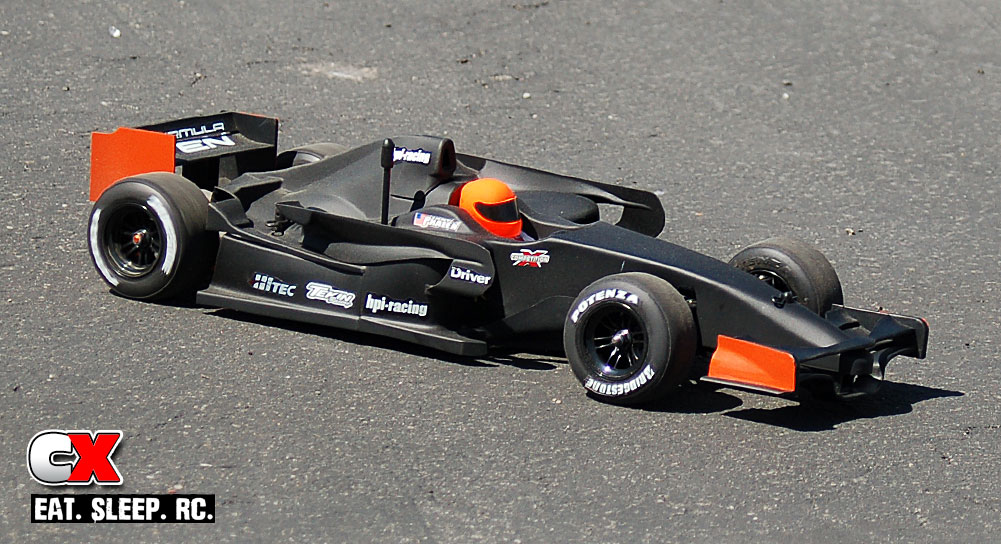
Formula Ten gets a F1 Makeover
A couple months ago I did a full review on the HPI Formula Ten. I enjoyed the car for its scale looks, quality parts and, more importantly, the price tag! That great price, however, did mean that HPI had to replace some key performance parts with easy-to-maintain units. For example, a gear differential was installed instead of a ball differential. The rear suspension was controlled by a tube damper instead of an oil-filled shock, and bushings were included in the kit instead of a full set of ball bearings. While that may not seem to be like much, the omission of those parts did hurt the potential performance of the Formula Ten. Thankfully I received a box in the mail with a note letting me know the F10 had a second chance at life. Follow along as I build up the HPI Formula Ten to racer-spec status.
 Electronics
Electronics
The Formula Ten is a pretty light car. That being said, I decided to stick with the power system I used in the original article as it supplied more than enough power for this 2wd F1 rocket. A Tekin RS speed control and Redline 17.5 motor were installed and fit comfortably in the chassis. This setup has been winning a lot of races around the country lately so I figured it should definitely continue its duty in the F10. To provide a little more juice this time around, a Team Orion Rocket Pack 4000 was charged up and ready for go. For steering duties, I also kept the Hitec HS-7940TH servo. While the torque is a bit overkill for this car, the transit speed (time it takes to go from full steering lock to steering lock) is something you need for light, nimble cars. For complete control, I dropped in HPI’s new 2.4GHz DSSS radio system. I’ve used this new system in quite a few projects lately and really like it. Range and response time are both excellent. In addition, the receiver requires very little space on the chassis. Expect to see this system in a lot of HPI’s upcoming releases!
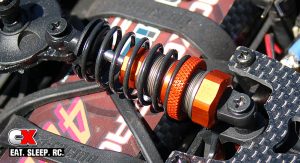 Chassis & Suspension
Chassis & Suspension
There’s not a lot of options at the moment for the chassis of the F10 (if anything I’d like to see a few more T-Bar options), so I kept the stock chassis and wing set installed. Thankfully there are some key suspension upgrades that really make the F10 an amazing little car. Up front, I swapped out the stock steel axles for a set of super-lightweight Fluorine-coated aluminum units. Moving rearward, a woven carbon fiber top deck keeps chassis flex to a minimum. To hold the Hitec servo in place, I installed a set of HPI’s orange anodized servo mounts. To control the rear suspension damping, HPI’s threaded, oil-filled aluminum shock was installed and attached to a woven carbon fiber damper plate. This shock is one of the first changes you should make to help the handling and tuning of the F10. Finally, the motor pod is surrounded by all kinds of orange aluminum. These aluminum pieces help stiffen the motor area and also help dissipate motor heat during longer runs.
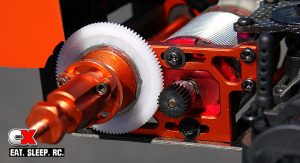 Drive Train
Drive Train
While only a few changes were made to the drive train, they were critical changes that really transformed the F10 into a track terror. First off, the stock plastic bushings were removed and a full set of high-quality ball bearings were installed. This change alone makes a huge difference on the efficiency of the drive train and provides, in most cases, longer run times. All the way out back, a super-smooth ball differential and lightweight aluminum rear axle were installed. The axle saves a ton of weight and lets the F10 accelerate much quicker. The ball diff, well, is probably the single most important upgrade I can suggest for the F10. Adjust this correctly from the start and your Formula Ten will reward you with exceptional handling.
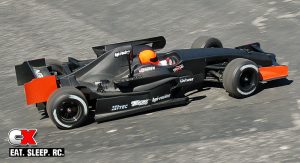 Body, Wheels & Tires
Body, Wheels & Tires
The original article features a paint job right off the box…solid white with some stickers. Doing some research on other Formula Tens, I found solid yellow, solid red and lots of solid black. Sorry, but boring. I decided to change it up a bit and go with something that some manufacturers do during their real prototyping stage; flat black! I did, however, add a splash of orange here and there to match all of HPI’s orange-anodized parts. Stock wheels were used on this project, but I wrapped them in HPI’s high-grip compound Bridgestone slicks. Because of their softer compound, these tires provide a ton of grip on most surfaces and are definitely high on the must-have priority list.
The Drive
Lucky for me, our ‘wet’ season is only about 3 days here in California. My early-spring test session treated me to a slightly warmer 82 degree day. That’s good, as the high-grip HPI Bridgestones would build up heat quickly to provide maximum traction. After setting up a small, curvy track at my secret test location, I set the F10 down and took a few slow laps. The Bridgestones seemed pretty good on the first few passes, but the only real way to find out was to lay down some fast laps. Traction went from ‘pretty good’ to ‘far superior’ this time around! I could almost punch the throttle coming out of the corners and even though the electronics were identical from the original test (other than the battery), the F10 felt a lot faster down the straight! There was still quite a bit of steering (thanks to the soft front tires), so I think a final change would be harder front springs or perhaps going back to the original front tires. I’m pretty confident that the F10 would hold its own on a track against some of the other more expensive F1s on the market.
Final Thoughts
As you can see, with a little work and minor tuning, almost any car or truck can be transformed into a competitive track vehicle. The wonderful thing about HPI’s Formula Ten is that it’s possible to do so without emptying your wallet! The basic car logs in at around $120.00. Purchasing the 3 key parts to superior performance (ball diff, oil-filled shock and soft tires), you would only be set back around an additional $100. The best part is that you don’t have to upgrade everything all at once; you can build when your budget allows. HPI’s Formula Ten is the perfect choice for anyone interested in getting into RC.
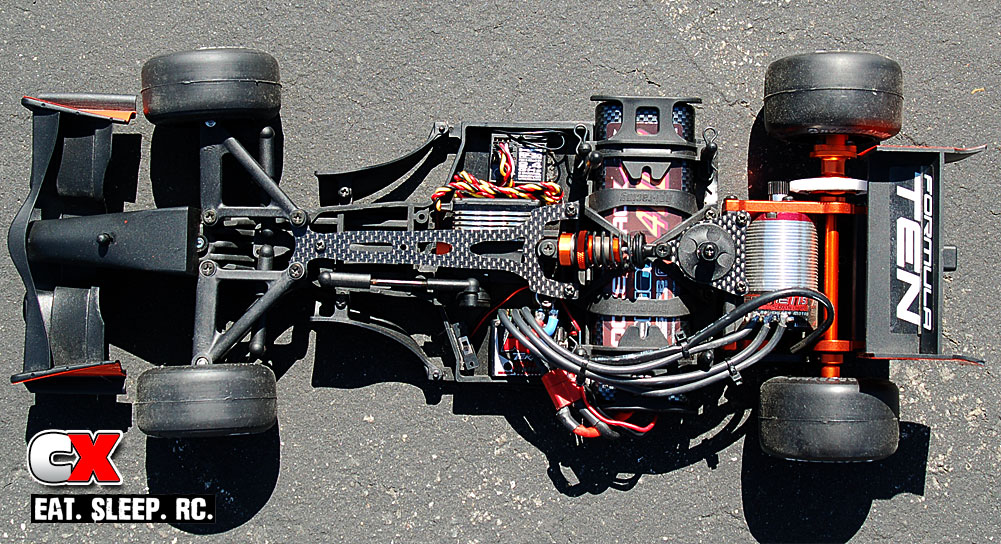
Parts Used
HPI
hpiracing.com–
• Formula Ten Type 16C Body, #102869
• Ball Bearing Set, #102877
• Ball Differential Set, #102878
• Threaded Aluminum Shock Set, #102879
• Aluminum Hex Wheel Hub, #102908
• Aluminum Fluorine Coated Front Wheel Shaft, #102909
• Aluminum Servo Mount Set, #102910
• Aluminum Motor Mount, #102911
• Aluminum Left Bulkhead, #102912
• Woven Graphite Upper Deck, #102913
• Woven Graphite Friction Damper Plate, #102914
• Bridgestone High Grip FT01 Slick Tire M, Front, #103016
• Bridgestone High Grip FT01 Slick Tire M, Rear, #103017
• Aluminum Rear Axle Shaft, #103018
Hitec
hitecrcd.com–
• HS-7940TH Digital Servo, HS-7940TH
Tekin
teamtekin.com–
• RS ESC, TT1152
• Redline 17.5 Brushless Motor, #TT2251
Team Orion
teamorion.com–
• Rocket Pack 4000 25C, ORI14107
Gallery
 CompetitionX CompetitionX is the most up-to-date source for RC Car News, Reviews and Videos for Radio Control. We also have the most comprehensive Manual Database on the web.
CompetitionX CompetitionX is the most up-to-date source for RC Car News, Reviews and Videos for Radio Control. We also have the most comprehensive Manual Database on the web. 







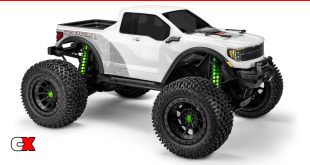
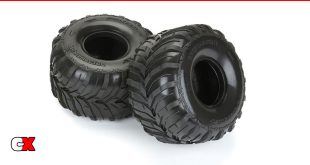
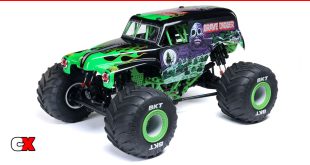

What size pinion gear did you use on this car?
Hey Aaron.
I started with a 24 but think anything from around 24-27 would be a good start (depending on your track size). That’s with a 17.5 motor. If you are running in any one of the Formula 1 series (that require a 21.5 turn motor), you might adjust that upwards from a 28-34 tooth pinion.
hy ! nice review !! i have a question …. if you had to chose between the sakura fgx and the hpi f10 wich one would it be ?? thanks !!!
Hey Renato.
The F10 is a great car but unfortunately I haven’t been able to get it to work on all surfaces. The FGX, on the other hand, is a fantastic car that, thanks to it’s independent rear suspension, has been a hero at almost every track I’ve run at. The FGX also has a lot more aftermarket support (since it’s newer and now more popular) so that’s another thing to think about. I would go with the FGX.
do you have a close up of shock mounted? the hole closed to front on mine the screw or stock ball just drops in no screwing
Hey Terry. Luckily I found this one so I hope it helps you out: http://www.competitionx.com/wp-content/uploads/2012/08/hpi-f10-shock-close-up.jpg